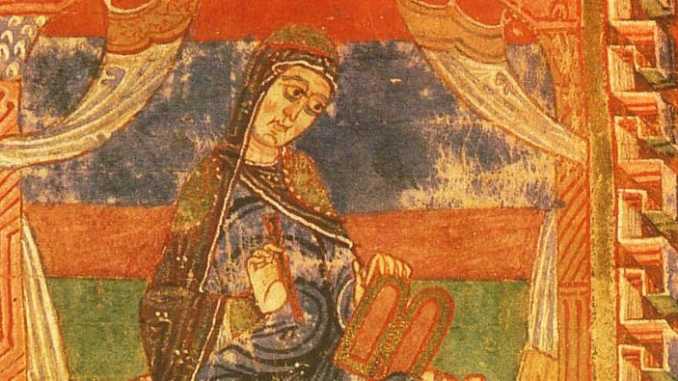
Queen Radegund was one of the most celebrated and beloved holy women of her time. While other Frankish queens were known for their notoriety, Queen Radegund was praised as a role model for women.[1] She was a Merovingian queen who founded her own monastery in Poitiers. She was devoted to the poor. Because of her charity and religious devotion, she became a saint.
Radegund was born around 520 C. E. She was the daughter of King Bertachar, King of Thuringia, a province in central Germany.[2] It was believed that the royal family was Christian.[3] When she was twelve years old, the Franks conquered her kingdom. Radegund became a prisoner to the Frankish king, Chlothar, and was taken to his palace at Athies. King Chlothar was the son of Clovis I and Clothild, the future saint who converted both her husband and her kingdom to Christianity. Unlike his mother, King Chlothar was not a saint.[4] In order to get the throne, he had his half-brothers murdered.[5]
In Athies, King Chlothar gave Radegund an education that was based on her rank. She learned to read and write. She also studied the Catholic religion, where she studied the Scriptures. This encouraged her pious nature.[6] She devoted herself to prayer and to the poor. King Chlothar soon came to have feelings for Radegund and desired to have her for his wife.[7] Radegund was reluctant to marry him and tried in vain to escape the marriage.[8]
Eventually, Radegund became Chlothar’s queen at Soissons in 540 C. E.[9] She was eighteen years old. The marriage produced no children.[10] King Chlothar took various women as concubines.[11] This allowed Queen Radegund to pursue ascetic interests.[12] She devoted herself to long hours of prayer and penance. She would leave the conjugal bed and would pray for many hours on the cold pavement of the Church.[13] Because of her religious routine, her husband and the court mocked her and called her “the queen-nun”.[14] Radegund also took care of the poor, especially sick women. She built luxurious beds and baths for them so she could bathe and tend to them.[15] Because of her charity, the queen was viewed by her people as a servant of the poor.[16]
In 550 C.E. King Chlothar killed Queen Radegund’s brother because he was the last male descendant of the Thuringia royal family.[17] This gave Queen Radegund a justified reason to flee her husband.[18] Queen Radegund fled her husband and sought protection from the Church in Tours. She was appointed a deaconess and travelled to Poitou to care for the lepers. However, her religious endeavours were interrupted when King Chlothar tried to bring his wife back to his court.[19] The Church intervened on behalf of Radegund. They negotiated with the Frankish king to help Radegund establish her own nunnery.[20]
In 560 C.E., Radegund founded the monastery of Sainte-Croix, named after the True Cross, in Poitiers. More than two hundred women lived in the monastery. They lived by the rules created by Bishop Caesarius of Arles (c.470-542 C.E.).[21] These rules emphasised strict enclosure. The nuns lived in poverty, frequently fasted, and prayed.[22] They also had to pursue intellectual activities like reading for two hours each day.[23] Queen Radegund died on 13 August 587 C. E.[24] The nuns could not attend her funeral because of the monastery’s strict laws.[25] However, St. Gregory of Tours attended the funeral. He said that her face was bright.[26] Soon, people began to say that miracles happened during her intercessions.[27] Queen Radegund was eventually made a saint. St. Radegund’s tomb can still be seen today in Poitiers.
Thus, while Queen Radegund did not have a happy marriage to King Chlothar, she eventually found her peace and freedom in the Church. This freedom allowed her to become one of the most intellectual women in the Middle Ages. Thus, Radegund was seen as the ideal Christian queen, and it is no wonder why many people of her time viewed her as a saint.
Sources:
Archibald, Edith Brigitte. “Rules for Canonesses, Nuns, and Recluses.” Women in the Middle
Ages: An Encyclopedia, edited by Katharina M. Wilson, and Nadia Margolis, ABC-CLIO, 1st edition, 2004.
McNamara, Robert F. “St. Radegund.” Saint Kateri Tekakwitha Parish, Saint Kateri Tekakwitha Parish, www.kateriirondequoit.org/resources/saints-alive/quirinus-rupert-mayer/st-radegund/.
“Radegund (c.520-587).” Encyclopedia of the Middle Ages, 2000, History Study Center, White, Duey.
“Radegund, St. (c.518-587).” Women in the Middle Ages: An Encyclopedia, edited by Katharina M. Wilson, and Nadia Margolis, ABC-CLIO, 1st edition, 2004.
[1] White, para. 1
[2] White, para. 2
[3] “Radegund (c.520-587).” para. 2
[4] White, para. 2
[5] White, para. 2
[6] White, para. 2
[7] “Radegund (c.520-587).” para. 2
[8] “Radegund (c.520-587).” para. 2
[9] “Radegund (c.520-587).” para. 2
[10] White, para. 2
[11] White, para. 2
[12] White, para. 2
[13] “Radegund (c.520-587).” para. 2
[14] “Radegund (c.520-587).” para. 2
[15] White, para. 2
[16] White, para. 2
[17] White, para. 3
[18] White, para. 3
[19] “Radegund (c.520-587).” para. 3
[20] White, para. 3
[21] White, para. 3
[22] Archibald, para. 6
[23] Archibald, para. 6
[24] “Radegund (c.520-587).” para. 3
[25]Archibald, para. 6
[26] McNamara, para. 8
[27]McNamara, para. 8

Be the first to comment